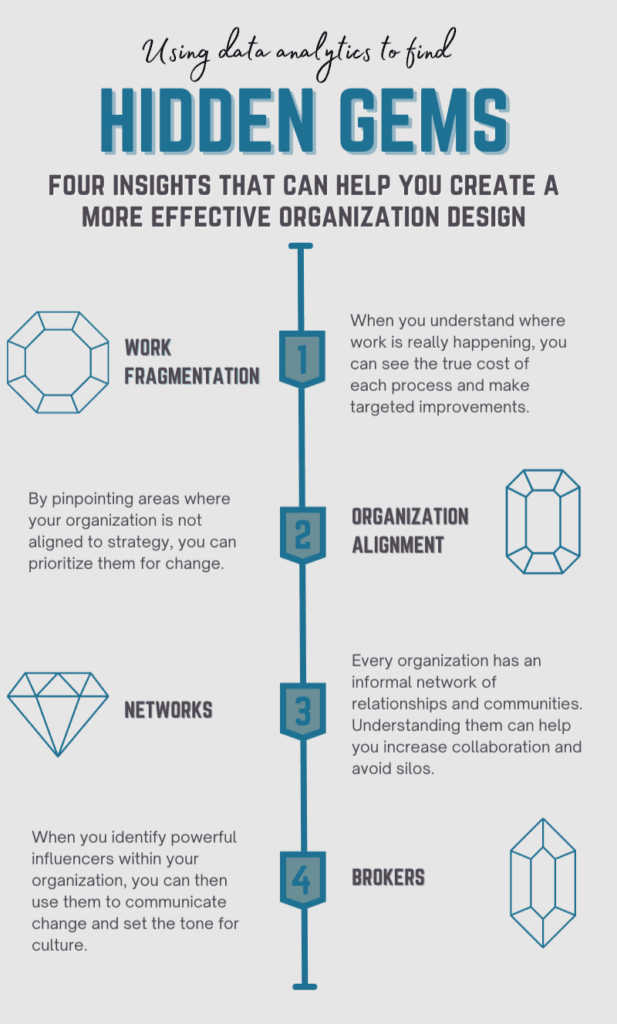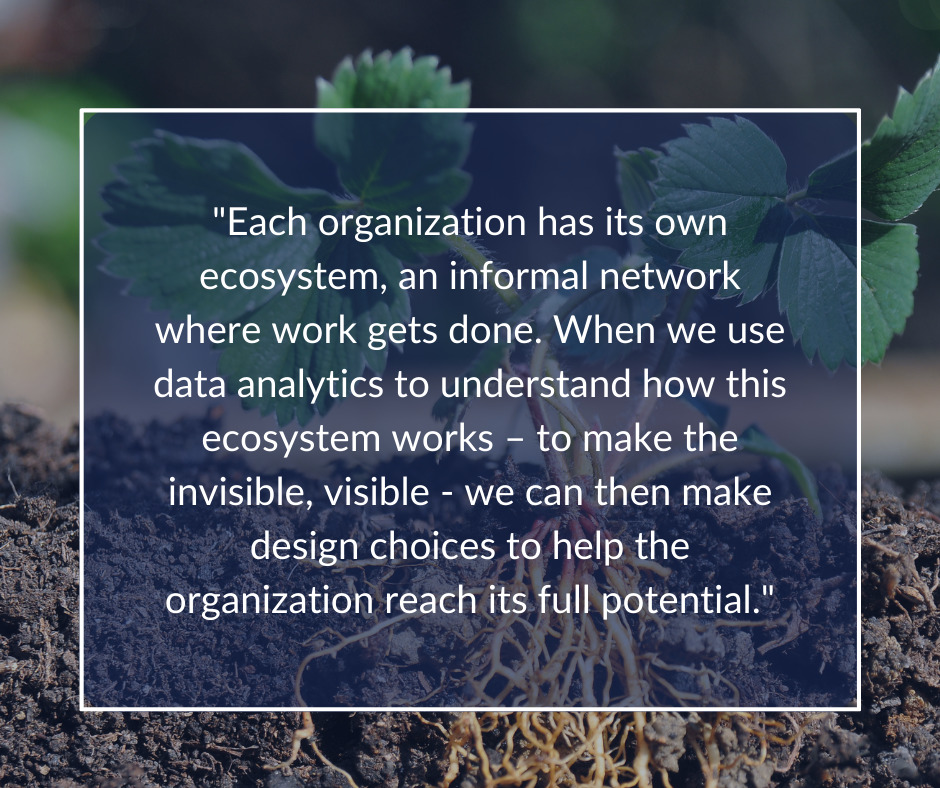A good gardener knows the health of the garden is influenced by what’s happening below ground. Beneath the roses and daisies is a hidden ecosystem of roots, airways, and irrigation systems that allow plants to flourish. A novice gardener might focus on the health of flowers and leaves, but a pro understands that the blooms will never reach their full potential if the world below the surface goes unchecked. The same holds true for an organization. Each has its own ecosystem, a vital network where work gets done. When we use data analytics to understand how this ecosystem works – to make the invisible, visible – we can then make the design choices that help the organization reach its full potential.
Fortunately, advances in how we compile and visualize data allow us to understand complex organizing patterns and informal networks of influence and communication. Today, we’ll explore four critical insights that can be revealed using data analytics. The “hidden gems” are hard to discover without the right tools but can be invaluable in creating an effective organizational design.

Work Fragmentation
The first of these gems is work fragmentation. We can learn where the work in an organization is really happening by surveying individuals and managers. We can then use data visualization tools to understand if activities are fragmented, see the true cost of each process, and determine if people are doing the right work. The results are often surprising. For example, leaders may think vendor management has been centralized. In reality, over 40 people across the organization are still working on vendor management activities.
This information can have a powerful impact on how an organization operates. It allows leaders to see how well the organization is living its operating model and be more surgical in their change efforts. It’s especially critical during a merger or acquisition, as it allows leaders to better understand the new organization and uncover where work is truly being done, as job titles don’t often tell the full story.
Organization Alignment
The second “hidden gem” is organization alignment, or how well an organization is positioned to deliver value. At AlignOrg Solutions, the process starts with a survey of executives based on our 66 Organizational Alignment Tips. The findings are shared using a heat map that shows and scores misalignments in nine key areas. Leaders may realize, for example, that their organization is excelling at employee recruitment. At the same time, however, it might be falling short at creating a culture that supports strategy.
By pinpointing where change is needed, we can often avoid a lengthy and complicated full redesign. Instead, we can tweak specific areas of the organization to help it work more efficiently and reach its desired outcomes while preserving those areas that are functioning well.
Networks
Next are networks – both the formal lines of communication and informal networks that are not apparent on an org chart. If we understand how these complex networks work, we can use that knowledge to drive performance. By collecting and analyzing information about organizational interactions, we transform the data into a visual web that helps illustrate key working relationships, decision-making patterns, natural communities, and isolated teams.
Once a leader understands the informal network, they can then make decisions that improve effectiveness across the organization. For example, if they can see where a process bottleneck exists, they can decrease that employee’s workload. Collaboration can be increased between silos to avoid losing critical information. Understanding networks is especially critical during a merger-acquisition or transformation. By knowing where critical networks exist, leaders can avoid unintentionally changing or breaking them during major organizational changes.
Brokers
Finally, we have brokers – employees who serve as influencers within the organization. These individuals may positively or negatively impact those around them and are often critical in getting work done. We can identify brokers using the same techniques employed to discover networks. Once leaders identify these individuals, they can use them to help communicate change and set the tone for culture. For example, a leader could identify the employees best positioned to communicate information to a large portion of the organization, then work with them to help spread the word about a redesign or strategy shift.
Harnessing the Power of Data Analytics

These are just a few of the valuable “gems” that data analytics can help you uncover within your organization. The more that you can understand the ecosystem of your organization – how employees communicate, the way work gets done and which employees hold sway over others – the more successful you will be at making organizational changes that have lasting positive impact.





